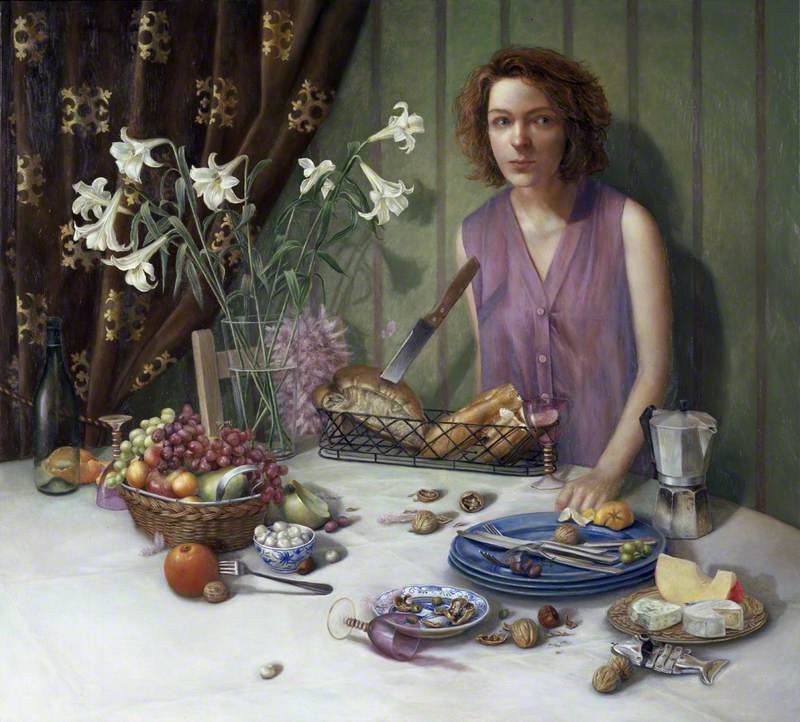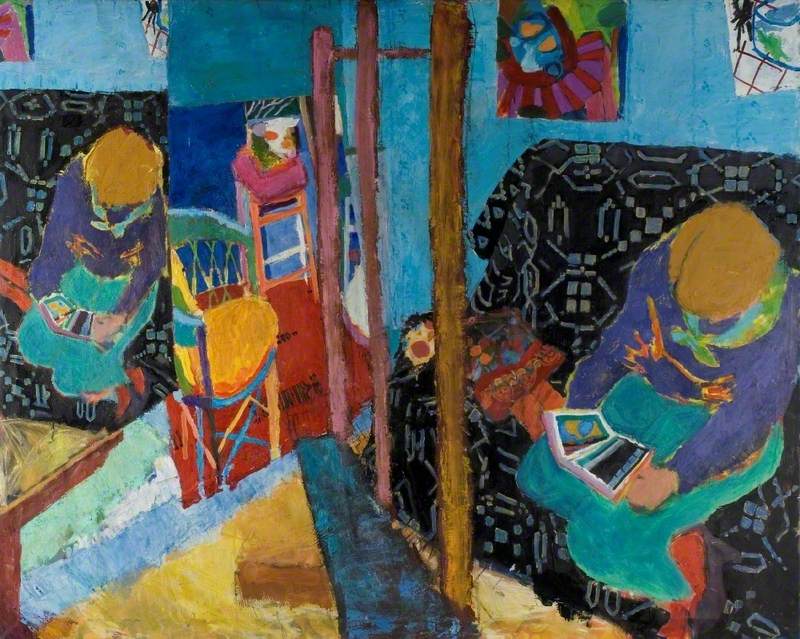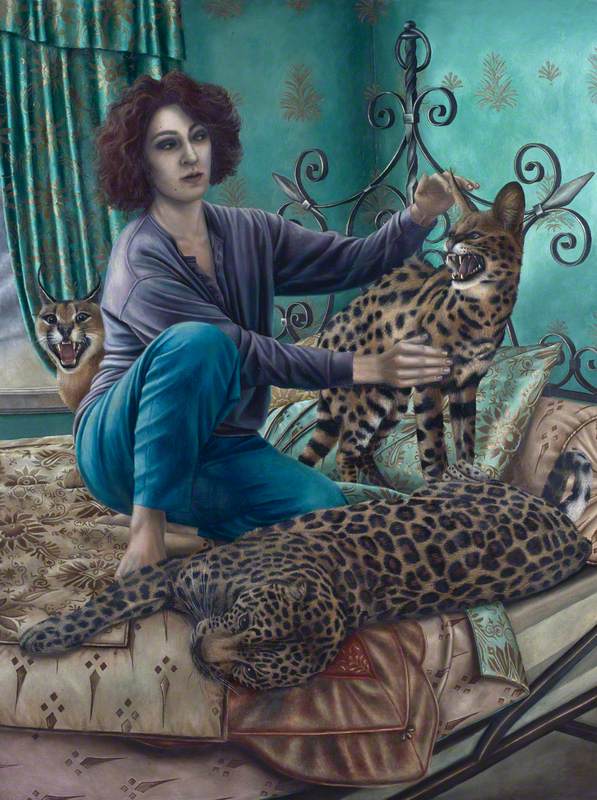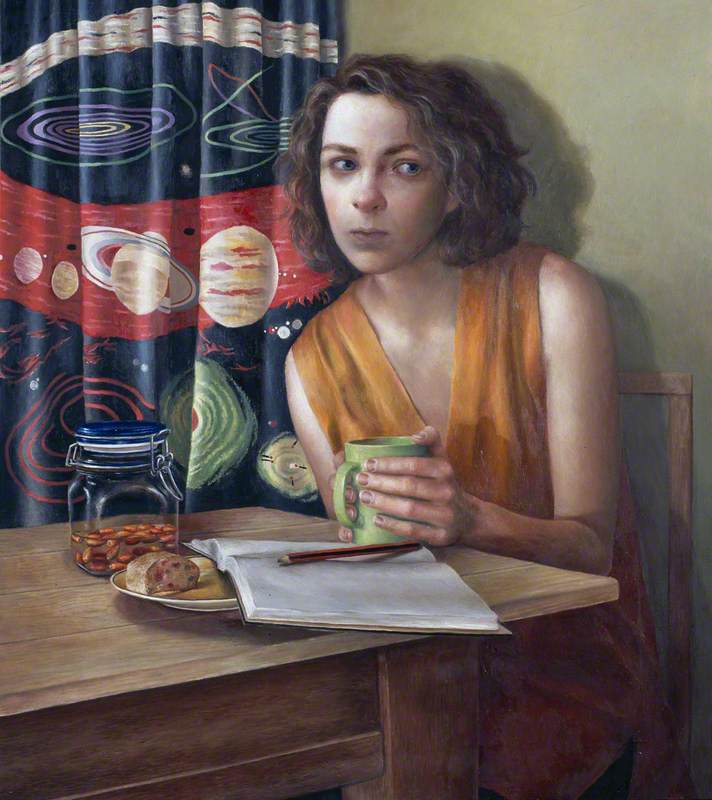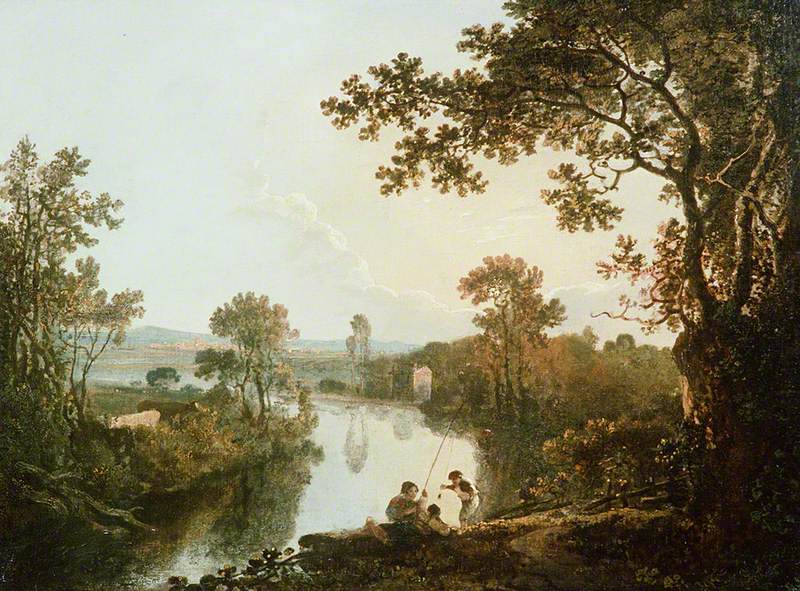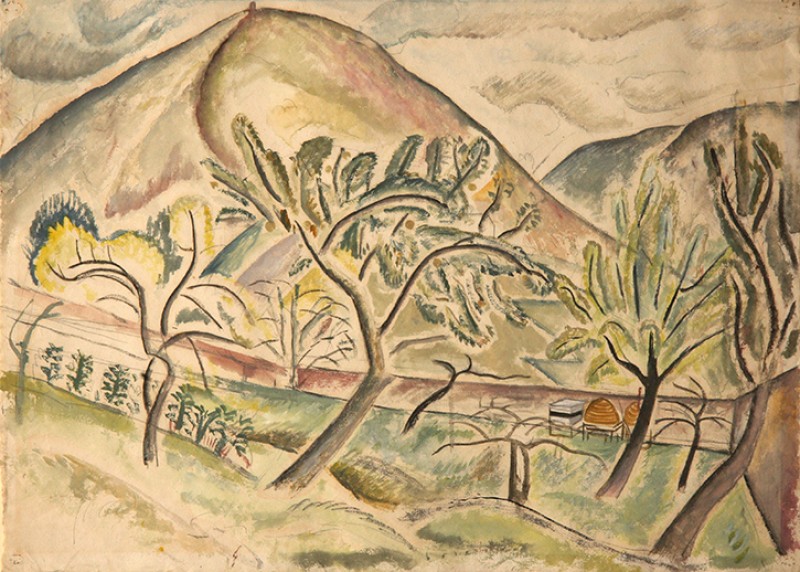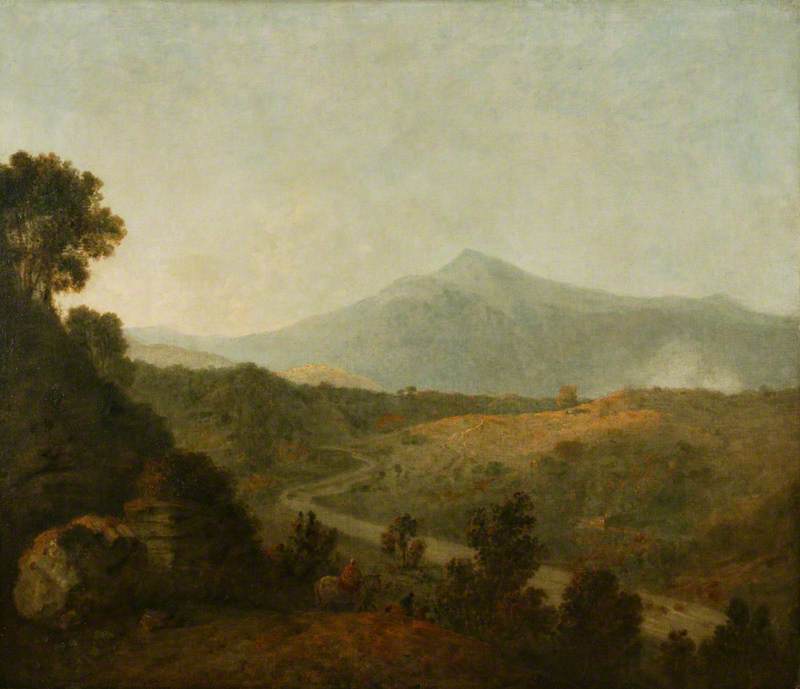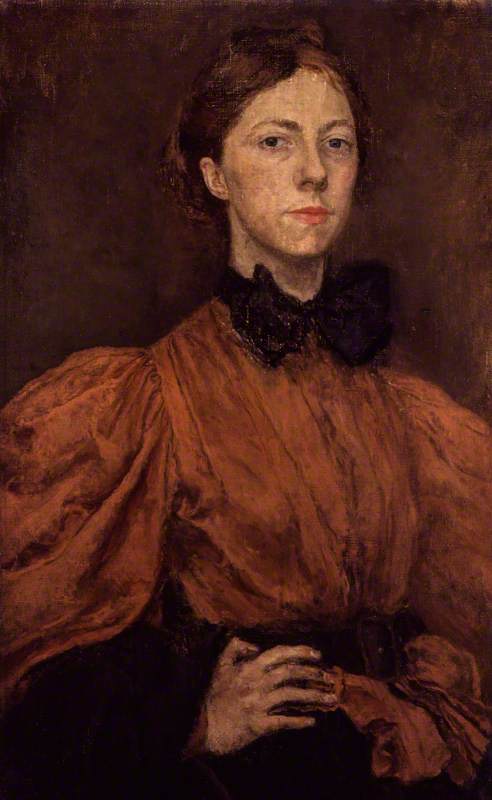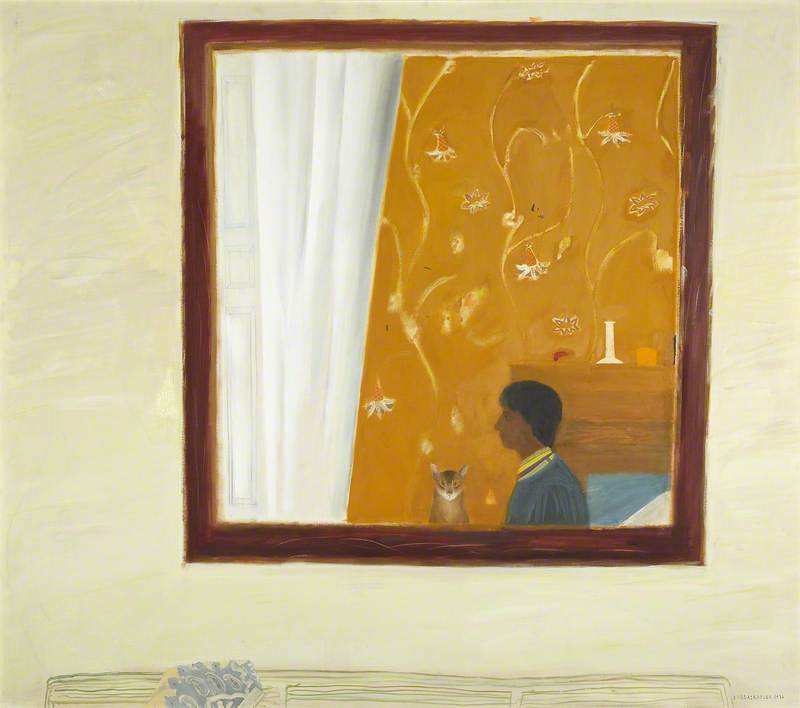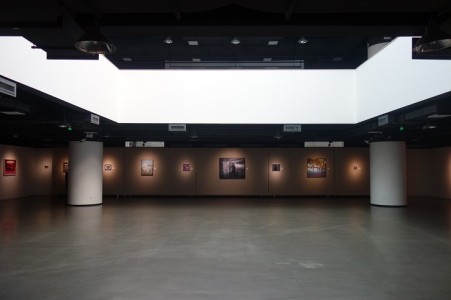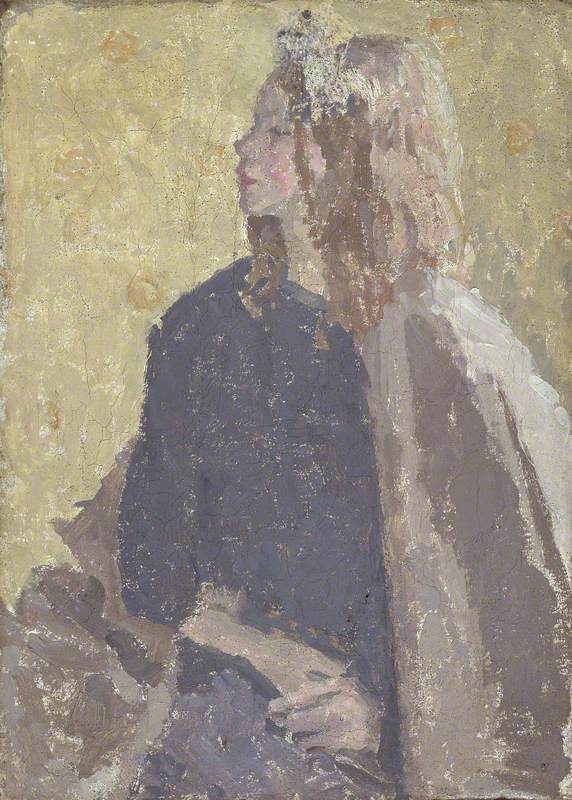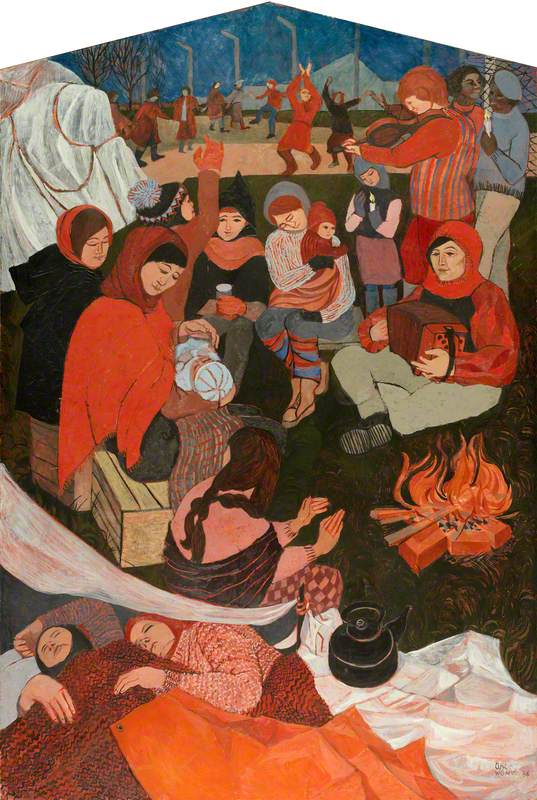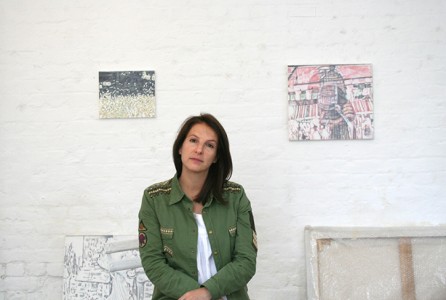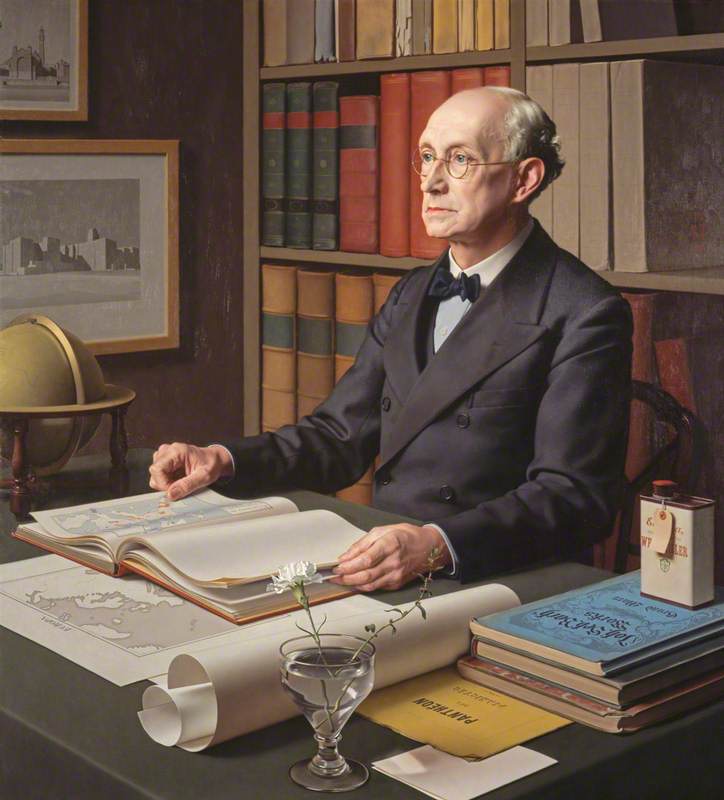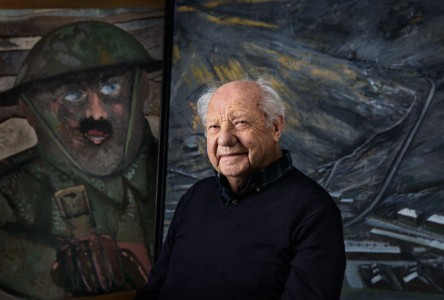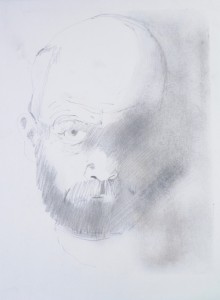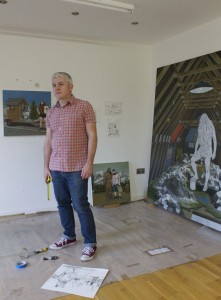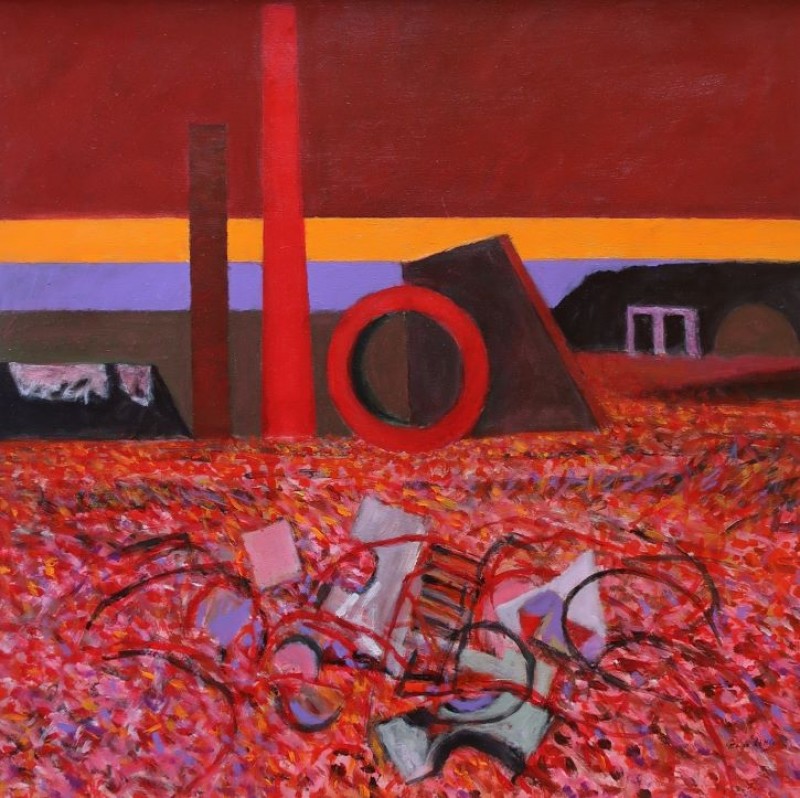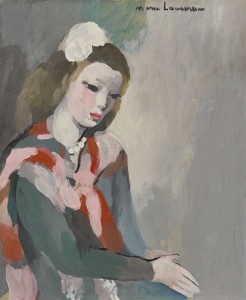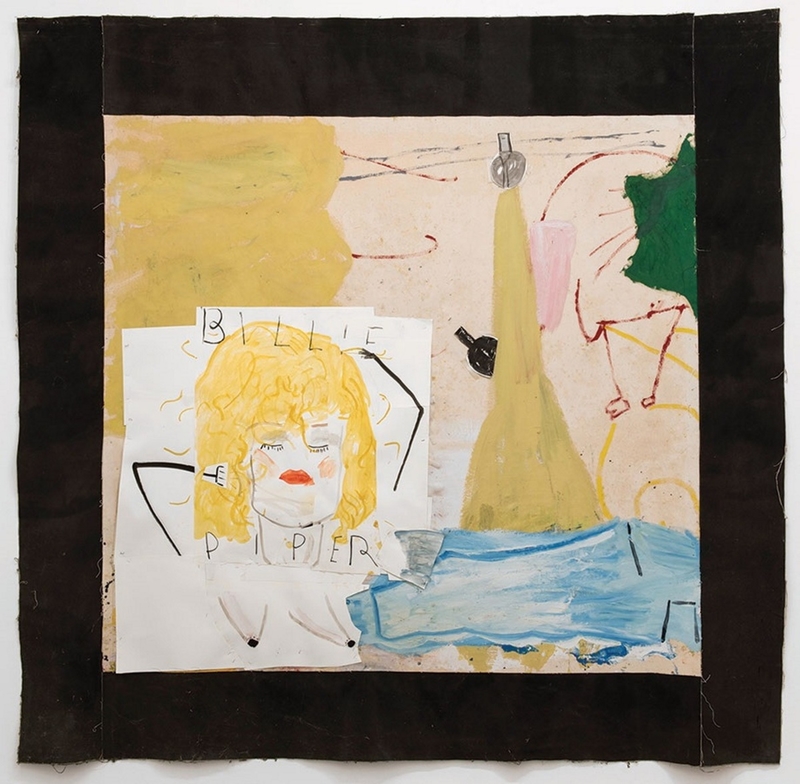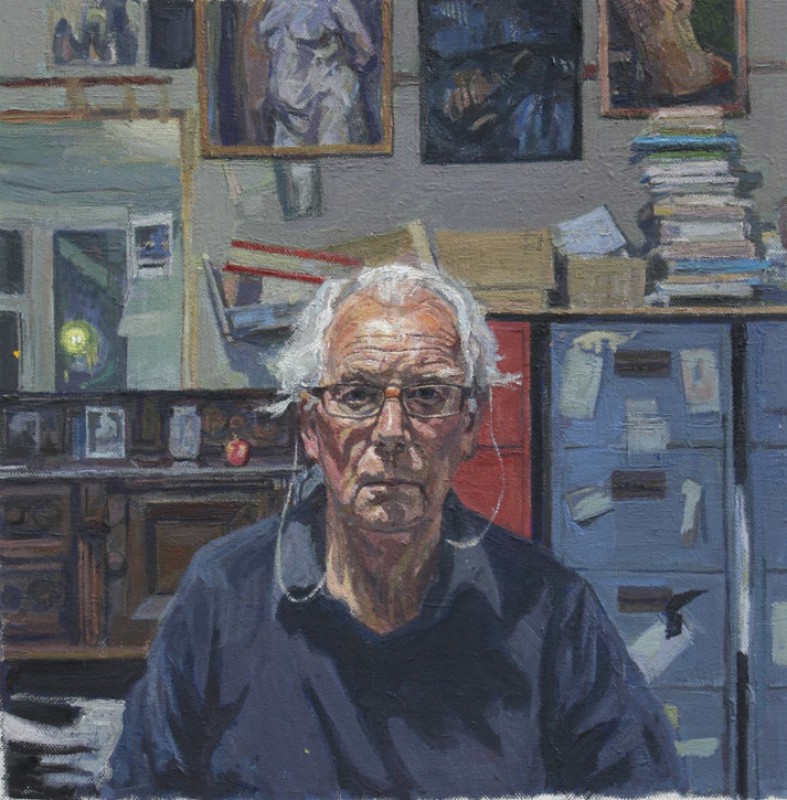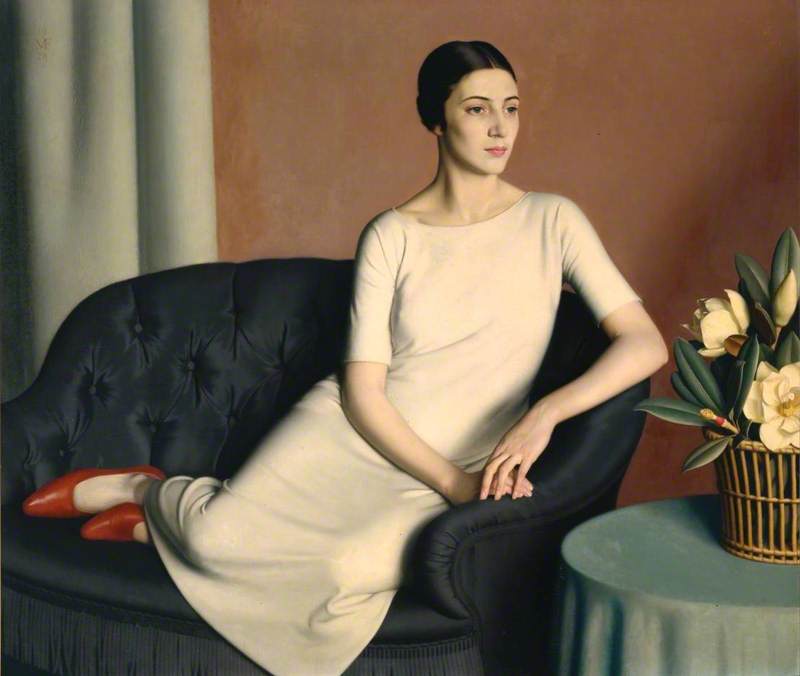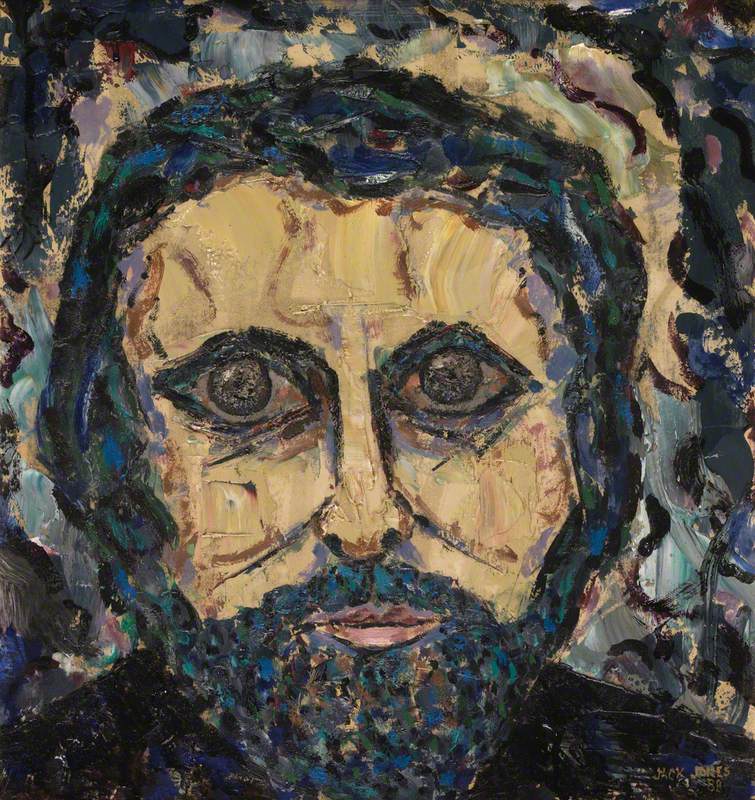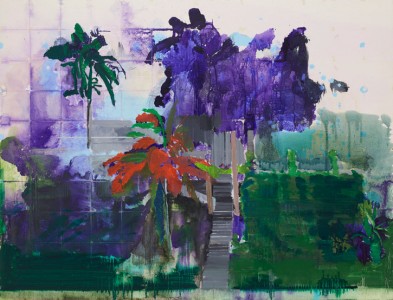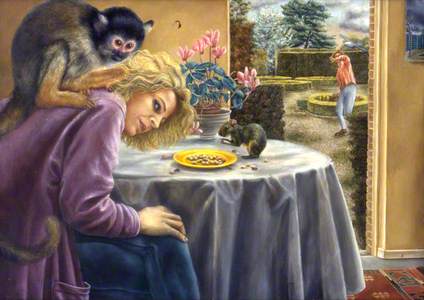Sally Moore, born in 1962, is one of the distinctive figure-painters of her generation. In her paintings she creates fictions that are truer than fact, fantastical situations that denote real feelings. Her surreal metaphors might be tigers in the sitting room, monkeys on her dining table, small boats setting out to sea, but through them, she tackles anxieties, embarrassments or expectations familiar to many of us. In this sense, her paintings are a kind of demonstration: a way of acting up and taking back control.
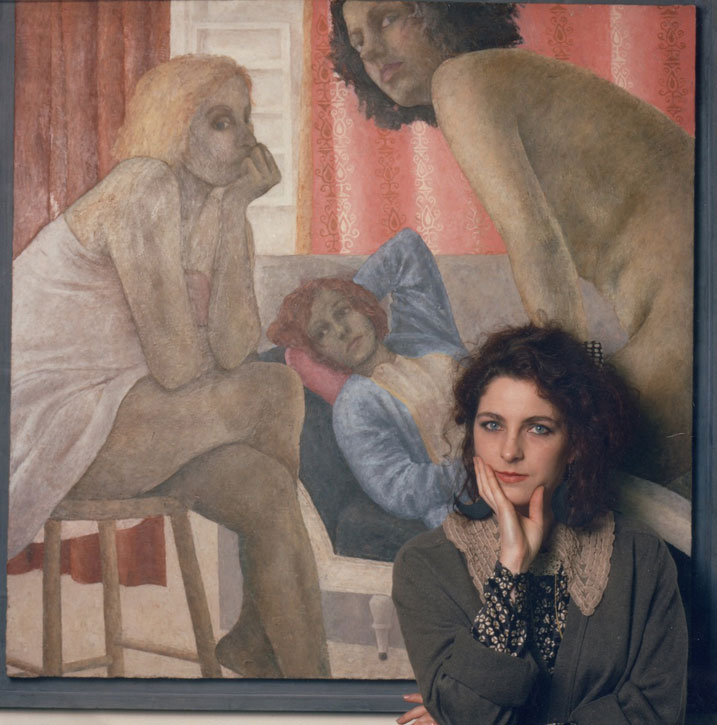
Image credit: Sally Moore
Sally Moore, c.1988, with her painting 'Conversation 2'
She uses herself as the model in her paintings, something that has been misunderstood at times to mean her themes are autobiographical, an exploration of one woman's personal neuroses. In fact, her modelling of figures on herself is, as she says, a matter of practicality and temperament: 'It's convenient because I have a clear idea of the pose I want and how the person should be feeling.' She likes to be self-sufficient and would be uncomfortable telling a model what to do and how to do it. The repetition of the figure has an interesting effect, redoubled by the surreal contexts, which is to clarify that these are paintings more concerned with the patterns of the mind than real, possible occurrences. When she appears in multiple it is not as twins or doppelgangers but as alter-egos.
Sally Moore grew up in Barry, near Cardiff. Her mother, Eira, was a choreographer and teacher and her father was the highly regarded painter Leslie Moore, who died when she was 13. From school in Barry, she went to Oxford University's Ruskin School of Art, then on to Birmingham College of Art for an MA. When she won a prestigious Delfina residency she moved her studio to London, where she still lives and works. She began exhibiting regularly at the Martin Tinney Gallery in 1995. Her numerous awards since then include the Discerning Eye, Welsh Artist of the Year and the Abbey Scholarship at the British School in Rome.
The novelist William Boyd has written about how seeing her paintings in concert reveals her ongoing explorations of mood, memory and states of mind.
Foreboding about social situations might be the state signalled by Remains, purchased by the Derek Williams Trust for the National Museum of Wales. It is one of her most seductive paintings yet hints at subversive feelings following a dinner party. Beyond the clean white tablecloth and Madonna lilies lie evidence of violence: an apple stabbed with a fork, a loaf that has a knife thrust into it, a spilt glass of wine, nuts cast across the table. The sole remaining figure is inscrutable. Is she in shock, glad to be alone or guilty? Might there be a sharp knife in the hand behind her back?
While she was a student, Sally looked particularly hard at Bonnard. A direct influence of his intimiste style can be seen in the intense colour, vertiginous perspective and rich pattern of her early works such as Figure in a Studio, made when she was about 21 and purchased by the Contemporary Art Society.
This image is a puzzle at first, made fascinatingly complicated by paintings within the painting. The composition is bisected by an empty, side-on easel. To the right, a woman sits reading on a Welsh-blanket throw. To the left, a painting leans against the corner wall and another easel bears a painting of the woman on the sofa, which presumably stood on the empty middle easel until recently. The whole brilliantly articulates a complex space and freezes a moment in time.
Her major painting, Inside Out, a little later, was meditative, harmonising opposites of orange and blue, yellow and purple.
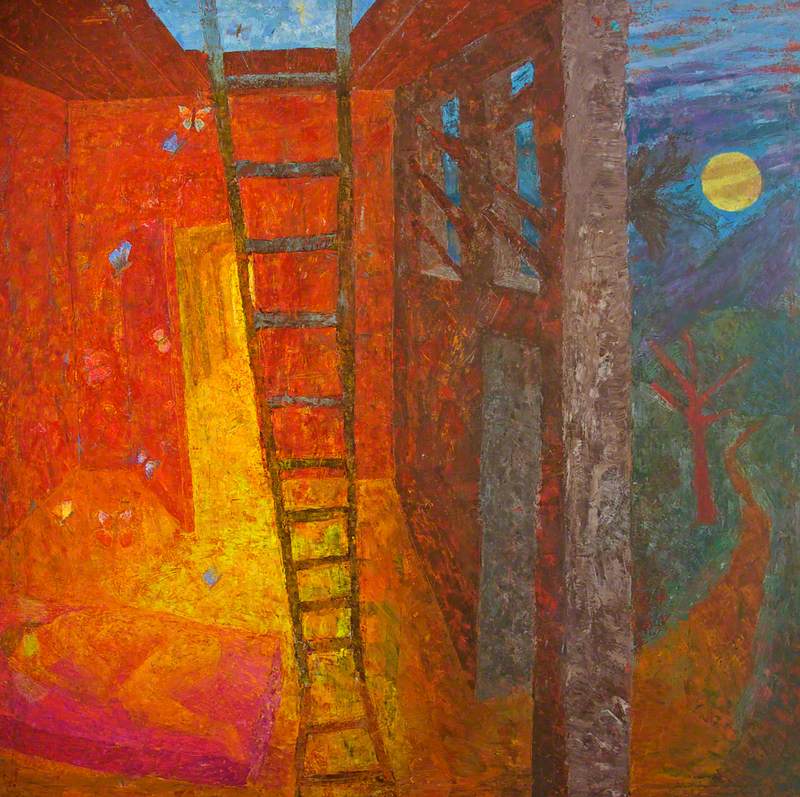
© the artist. Image credit: Cardiff Council
Inside Out 1986 (figure lying on a bed in a room with ladder, the moon outside)
Sally Moore (b.1962)
Cardiff CouncilA naked figure is sleeping in a room lit by a glow from a doorway. The wall has fallen away to meet a dawn garden and the sun rising over hills; a ladder leads from the bed towards a skylight, perhaps suggesting the sleeper's access to dreams. Chains of butterflies flutter upwards. She had a solo exhibition at Cardiff University in 1986 and the painting was bought for Cardiff County Hall.
In the late 1980s, she moved into what would be her characteristic mode of painting that took herself as the model and pursued extraordinary, rigorous detail. In around 1991, she started to paint on a support of board instead of canvas. This might sound a minor matter, but the changes in the work were clear. The smooth, resistant surface allowed her to achieve a new verisimilitude and she began working on a smaller scale with maximum control, removing gestural marks.
Her scholarship in Rome in 1992/1993 gave her an opportunity to study Giorgione, Titian and Caravaggio. She began using varnishes to unify and glazes to alter tone. As she wrote: 'I do wish to capture the quality of things – shiny fabric, a monkey's soft fur, a glint in the eye to suggest the eye is moist, the quality of skin.'
In recent years, she has gone back to the Old Masters many times, revisiting famous compositions in homage. She uses herself as a model still, but occasionally now needing a male figure too, as in This Charming Man.

© the artist. Image credit: the artist
This Charming Man
2015, oil on panel by Sally Moore (b.1962), collection of the artist
This painting leaves questions tantalisingly unanswered, as did her inspiration for it, Vermeer's The Girl with the Wine Glass. The Vermeer is usually considered a seduction scene, but why that strange gesture of the man opening his hand under the girl's? Has he given her the glass of wine or is he trying to take it away? In both paintings, he looks at her but she looks at us. Sally's mature woman seems confidently in charge.
These are fertile paintings to which each viewer or each moment may bring quite different responses. As William Boyd wrote of them in 1997 in Modern Painters:
'The mood and interpretation will be subjective: birds, a wooden boat, a monkey or butterflies will generate their own personal shiver or thrill. But there is nothing meretricious or flippant in the composition or the juxtaposition: they beguile, they unsettle, they perplex, they amuse, they enchant. The choice, in the end, is ours.'
Peter Wakelin, writer and curator
An exhibition of Sally Moore's latest paintings is at the Martin Tinney Gallery in Cardiff from 6th to 21st November 2019, with a private view on Tuesday 5th November 2019.
Sally Moore: Acting Up by Peter Wakelin, is published by Sansom & Company
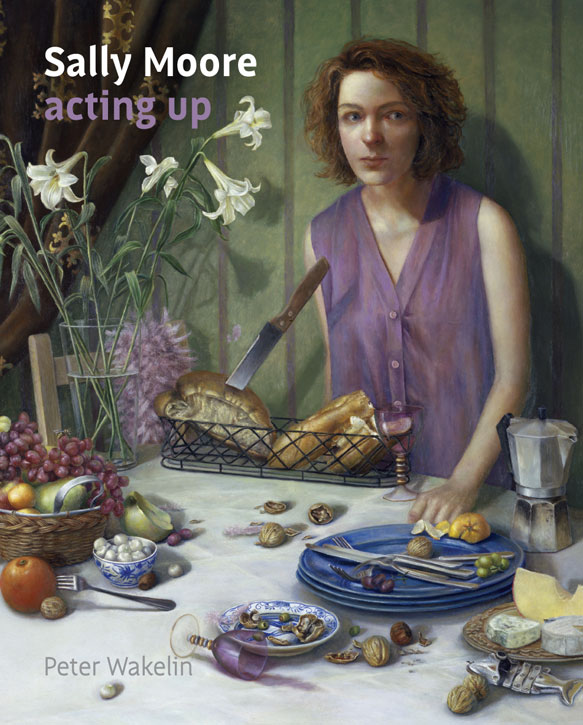
Image credit: courtesy of Sansom & Company
'Sally Moore: Acting Up' by Peter Wakelin
